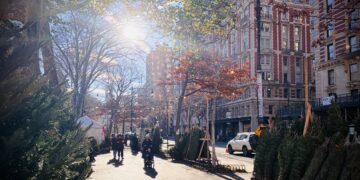
By Yvonne Vávra
I was once on a German roller coaster, in a place where — as would soon become apparent — the Germans are a little crazy about roller coasters. With every foot we climbed higher on the lift hill, I lost my mind a little more, as the looming dread began to hit me. Then, at the top of the first drop, the cars spun around. We were going to go down the wrong way. I was in despair. What on earth was happening? The final click, then a moment of calm, and what came next is hard to describe because I checked out. My mind hunkered down somewhere, and I went numb.
These past weeks have left me feeling much like that. Amid the constant deluge of breaking news, I’ve been struggling to get my mind back on track. Everything seems to be exploding and collapsing all at once — and not just on a global scale. Closer to home, there are smaller signs of the great unraveling that feel just as inevitable and uncontrollable. Another neighborhood bookstore closes, unable to compete with the algorithm-driven forces churning out discounts and convenience. Were we supposed to be strong enough to resist?
In fact, we have history on our side to prove we can take on the biggest players. Not that long ago, just a few Upper West Side moms stood up to arguably the most powerful man in New York City history. A man who had been invincible for three decades, destroying communities and displacing families without anyone daring to oppose him. Robert Moses used his various government positions to impose his will on the city, all without ever being elected by the people. He had no experience with things not going his way. But then, the moms took on Moses.

It was 1956, and Moses was at the height of his power when he decided to bulldoze a small, grassy, tree-shaded portion of Central Park, between 67th and 68th Streets, to expand the parking lot for Tavern on the Green. As was his usual approach, he planned to bulldoze first and shrug his shoulders later. But on April 9th, one of his engineers, who was checking out the area, accidentally left the blueprints for the lot behind when he went for lunch. The documents piqued the curiosity of Roselle Davis, one of the young mothers who loved and depended on that small portion of the park. It was their unofficial playground, adjacent to the Adventure Playground, where they could sit together and watch their children play. Davis went to tell another mom, Augusta Newman, who told her famous photographer husband, who told their neighbor, novelist Fannie Hurst, who then went on to draft a petition. They gathered 23 signatures. Moses ignored it.
In “The Power Broker: Robert Moses and the Fall of New York,” Robert Caro writes that the protest barely registered with Moses. “Twenty-three mothers? He had just finished evicting hundreds of mothers rather than shift a section of his Cross-Bronx Expressway a single block! He was at that very moment in the process of displacing five thousand mothers for Manhattantown, four thousand for Lincoln Center!” However, this tiny speck of parkland presented a big challenge Moses had never encountered before. These Upper West Side moms had access to money, lawyers, and the media — their block was brimming with influential neighbors. What’s more, Central Park held immense significance for New Yorkers, including those in the press.
Moses didn’t care. In the early hours of April 17th, he sent in his bulldozer. But it didn’t get far because Elinor Sanger spotted it from her bathroom window on the 12th floor of 75 Central Park West. She called other moms, who called more moms, and not long after, dozens of women, children, and dogs were running to Central Park for a face-off with the bulldozer. Newspapers, radio stations, and TV networks loved the story. The city was watching.
A few days later, Moses tried to use the cover of night to push through with his plans. To avoid the rotating guard the moms had set up from dusk until dawn, he sent his crew to the park after midnight to build a fence to protect the bulldozer’s work site. When the moms returned in the morning, they were stopped by the police while trees were being chopped into pieces. Moses had gotten his way, but the moms had won anyway. They had tarnished the commissioner’s popularity. For the first time, the media turned on him, and a lawsuit was underway. To avoid a trial, he eventually backed down and announced that he would build a playground instead of a parking lot. After all, the site had already been cleared of trees and vegetation. That’s how we got Tarr-Coyne Tots Playground, right next to the Adventure Playground. Even if the moms hadn’t brought Moses down, they had shaken his pedestal enough to contribute to his eventual downfall years later.
* * *
Yvonne Vávra is a magazine writer and author of the German book 111 Gründe New York zu lieben (111 Reasons to Love New York). Born a Berliner but an aspiring Upper West Sider since the 1990s (thanks, Nora Ephron), she came to New York in 2010 and seven years later made her Upper West Side dreams come true. She’s been obsessively walking the neighborhood ever since.
Subscribe to West Side Rag’s FREE email newsletter here. And you can Support the Rag here.









How I love this article! Not only beautifully written but a timely reminder of the power of collective action. Yes, it helps to have resources and visibility behind those actions but it starts with lifted voices and connecting with community to channel outrage into positive change. I hope many are inspired after reading it to lift more voices and connect in solidarity at this moment when it can make a difference.
I love, love, love this story. In my youth I was part of the movement that stopped Moses from building a highway through Fire Island.
Thank you, moms, for saving a piece of Central Park!
Saving Fire Island was a huge win for everyone and a huge loss for Moses. The more I learn about him, the more I realize he was a real SOB.
The SOB built bridges and tunnels for you to use. You are welcome.
That doesn’t exclude him from being a characteristically SOB.
He was a very complex character. Watch Ric Burns’ many part history of NYC. Of all crazy things, Moses didn’t even drive!
Thanks for this powerful vignette. One of the best written stories I’ve read in the WSR.
Good history to know, but the sad part is the thousands of working class families, people of color, immigrants, but also working class whites, lost their battles with Moses to the eternal shame of our city. The legacies of the those defeats linger in terms of choking traffic congestion, environmental degradation, isolation of communities, high asthma rates, etc.
Typical white guilt comment from typical UWS liberal… Exhausting… Putting aside your virtue signaling, do you even know anything objective about Moses? He built 658 playgrounds in New York City, increasing the number from 119 to 777. He oversaw the construction of 13 bridges and tunnels, including the Triborough Bridge, Queens Midtown Tunnel, Bronx Whitestone Bridge, Henry Hudson Bridge, and Brooklyn Battery Tunnel. I assume you never use bridges or tunnels to leave Manhattan? He also built three zoos, a series of massive outdoor pools, and city park acreage more than doubled, to 34,673 acres! Nobody will ever be perfect and pure enough for your progressive mind, very sad to simply things like this.
Do you know anything about Moses? Do you know about him building the bridges on the highways to the beaches low enough to keep buses from going, specifically to ensure that only people with cars could get there? Or about him choosing to put highways through low-income neighborhoods specifically, presumably because they didn’t matter?
I love Riverside Park, I love Lincoln Center, there are many things to be grateful for. But that doesn’t mean his legacy is untarnished or entirely admirable. Recognizing that all humans are frail does not mean denying that absolute power corrupts – or that Moses got out of hand and when he was toppled, it was well past time.
Even people who do great things can also do awful things (in fact, I would say they often do, because the same lack of perspective that leads people to ignore impediments that would otherwise stop them can lead to terrible acts of cruelty and destruction).
Having to deal with people who are incapable of understanding this is also exhausting.
You are so naive and idealistic. Its not only Moses. All cities in the world try the best they can to always build highways through poor neighborhoods. Its just logical and pragmatic. Yes, the world is unfair!
Yes, and it is wrong. He is known to have been particularly quick to disregard the people he displaced. It is not naive or idealistic to acknowledge that or the complexity that urban planning involves. It is naive to think you can ignore those issues forever.
(Btw – you have some reasonable points, but you are pretty obnoxious in style. Any particular reason?)
A great story behind a lovely, well used little playground for the littlest kids. Thank you! May we too find ways to turn the bulldozers’ crushing effects into future civic benefits for all. It can be hard to see how at the moment, that is for sure.
I remember this well. What led to front page headlines and sparked outrage among the public was the blocking of traffic on Central Park West by mother with baby carriages.
It is not possible right now, to imagine even the little playground that might be salvaged or built from the bulldozing of seventy or eighty years of joint sacrifice, goodwill, alliances (sometimes not for good, sometimes for very good) with four dozen nations (but chief among them a long standing top ten or so) that are being bulldozed this last 10 days. A lot that our parents and grandparents worked, served, fought and died for. But a very good story, thank you. We can hope something good can be envisioned one day, from this rubble.
Yvonne, your second paragraph in particular is the truest, most pertinent thing I’ve read around here in quite some time (hence likely to ruffle various feathers), and the whole piece is very uplifting. THANK YOU!
Wait, I thought white privilege was bad, so are the mothers heroes or villains?
This is not what white privilege refers to. But then, of course, you know that.
Imagine what would have happened if the mothers were black or Hispanic women in the Bronx. (Oh wait – we don’t have to imagine. We know.)
Good question. These rich white people are always bad- except when their taxes and spending funds the city.
Good grief! Are you negative about everything?
Trying to balance the article is not negative. It’s ‘well rounded’.
Privilege is a pyramid and whiteness is one thing that will place you higher up the pyramid. In this example Robert Moses, a white businessman, because of his political power and the audience he was developing his projects for, other white businessmen, they all out ranked “housewives” in the scheme of political influence when it came to urban planning. For a bunch of women, who at this time couldn’t even open a bank account without their husbands signature, to take him on and win, it quite literally is a David and Goliath story; just like the legacy of Jane Jacob’s. I guarantee all of the people in this story benefitted from public transit, public schools, public museums, public health, and rent regulation, and all of the other things you usually rant about, and you know what? Their neighborhood was better because of it. But you’re getting cheaper eggs or something right?
Progressives love hating on Moses while enjoying daily the infrastructure projects he built… is everything always seen from an oppressed/oppressor dynamic with the left?
Robert Moses built many things we utilize everyday, he was also a self avowed racist. Both things can be true and objective at the same time. Marion Sims operated on enslaved women without anesthesia who were seen as so disposable that we don’t even know their names, yet most of the modern advances in gynecology came from these procedures he performed. A lot of what we know about the physiologic effects of hypothermia came from experiments nazis performed on Jews during the holocaust. Talking about the horrors of the past is how we prevent them from happening again in the future. The aversion to talking about racism because it makes one uncomfortable is not an efficient tactic to move forward as a society. Critical thinking skills related to historical context is one of the most valuable academic and intellectual skills one can have, and sadly, we are creating a society where these are seen antisocial behaviors. There are many books written about and related to this subject, I recommend starting with Animal Farm, 1984, and Fahrenheit 451, and then moving on to The Diary of Anne Frank, To Kill a Mockingbird, and Roll of Thunder, Hear My Cry.
The majority of the Bronx was White when the Cross Bronx was planned,the majority of the South Bronx was White during this time also. Their “privilege didn’t protect them.
That is interesting- have to look into that more.
But white privileged is not saying white people have not endured horrific things. It is one of those thoughts that requires the ability to remember that there is more than one kind of injustice and that sometimes they cause even more harm when combined.
Moses was never a businessman.
One of the big themes that Caro lavishes on us is how Moses didn’t give a damn about poor people. Witness the idea of not having buses go to Jones Beach because the riff raff without cars might want to have some relief from the summer swelter from the boroughs. Oh, and when you’re on one of those windy sections of the Southern State Parkway you can remind yourself how yes, Moses would detour the route dramatically when his wealthy friends complained that the parkway would displace them from their homes. I remember when I was a child and my parents would visit my grandparents in the Bronx on McCombs Road. The talk was always about their friends that were forced to move to accommodate the Cross Bronx Expressway.
Oh! A story I did not know a thing about and now I feel richer for knowing! Thank you for sharing this, especially at a time when many may feel that their little voice is too small to be heard – not if we raise it together, strollers and puppies and mama bears of all sorts in tow!
Moses apparently closed off a large section of Central Park (around 22 acres I think) because his friend said there needed to be a bird sanctuary in the park. Moses didn’t know anything about birds or bird sanctuaries and didn’t consult anyone who did. So for decades this large section of the park was closed to the public until someone in a Fifth Avenue apartment looked out the window and wondered what that tangled mess was all about and contacted the CP Conservancy. It took years to clear out all the invasive plant species and the other overgrown plants in the area that was basically neglected to create the Hallett Nature Conservancy, which is open to the public as it should be. Robert Moses accomplished some amazing things but his unchecked power combined with his arrogance also led him to make plenty of mistakes and cause harm to many New Yorkers.
It was indeed closed off in 1930, but it was cleaned up and designated a bird sanctuary in 1980, still closed to the public. After becoming overrun by invasive species, rats, etc., it was overhauled in the early 2000s and opened to the public. It is 4 acres, though, not 22. https://www.centralpark.com/blog/10-things-know-central-park-hallett-nature-sanctuary-visiting./
Thank you for this wonderful — and inspiring! — article.
“Davis went to tell another mom, Augusta Newman, who told her famous photographer husband, who told their neighbor”
What famous photographer Newman? Does he have a first name? Or is he also the one-named Newman who worked for the Postal Service on “Seinfeld”?
Arnold Newman?
Yes, it was Arnold Newman
Maybe that playground was Moses’s form of retaliation in the guise of a concession. All sloping concrete and asphalt I’ve always thought of it as a death trap for kids.
Believe you are thinking of adventure playground, this is referring to the Tots playground which is much newer and has softer surfaces for smaller kids
What a wonderful, compelling and well-written article highlighting an important episode in UWS history. Let us not forget the power of collective action.
Amazing. There is a long history of parental activism in the neighborhood.
Is the pkayground named in their honor and I’m just missing it?
One sentence confused me: “To avoid the rotating guard the moms had set up from dusk until dawn, he sent his crew to the park after midnight to build a fence to protect the bulldozer’s work site.” Don’t you mean “from dawn until dusk”?
Great piece. Grew up right there. One point of clarification: The “Adventure Playground” name came later as a result of a sandy, concrete, mess of a redesign of the playground that existed there.
This is terrific!